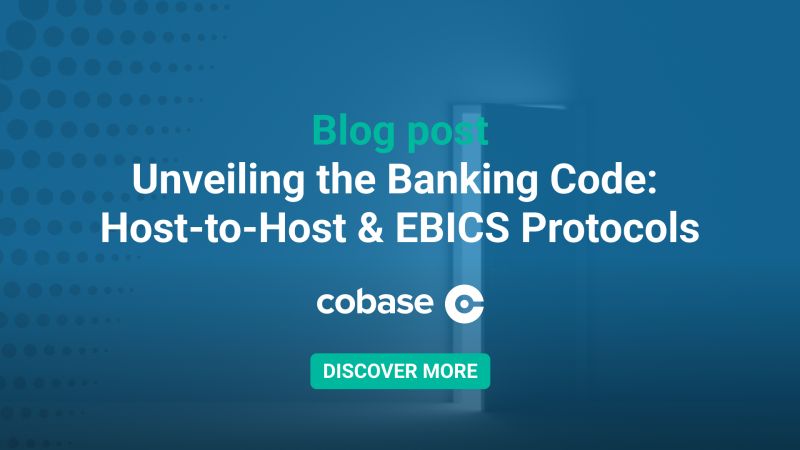Host-to-Host (H2H)
A Host-to-Host (H2H) connection represents a direct, secure, and private linkage between a corporate’s system and the bank’s system. It is designed to support the exchange of bulk financial data and messages, offering a streamlined way of communicating directly with banking partners.
A key component of H2H connections is the flexibility to support various file types and formats, ranging from simple text files to complex XML files. This gives corporates the freedom to transmit diverse financial data in the most convenient format. Unlike SWIFT protocols, which rely on a third-party network, H2H connectivity allows for direct communication, potentially reducing transmission delays and eliminating intermediary costs.
H2H connections are appreciated for their speed and reliability. As the data is transmitted directly between the corporate and the bank, it can significantly decrease the time taken for data transfer. It’s especially advantageous when large volumes of data need to be transmitted in a time-sensitive manner.
Security is another hallmark of H2H connections. Given the private nature of these connections, the risk of data interception or manipulation is significantly reduced compared to public networks. Moreover, additional security measures like encryption, authentication, and digital signatures can be employed to fortify the connection further.
However, H2H connections do come with their own challenges. Setting up an H2H connection requires considerable technical expertise and resources. Corporates need to ensure compatibility between their systems and those of the bank, which may involve substantial IT effort.
Security maintenance is also a concern. While H2H connections offer enhanced security, they also demand rigorous security measures to prevent data breaches. This can mean investing in advanced security technologies and adhering to strict data protection standards.
Furthermore, when dealing with multiple banks, corporates may have to establish and maintain separate H2H connections with each bank, all potentially having different technical requirements. This can multiply the complexity and costs of managing these connections, creating a considerable administrative burden.
H2H connections offer a fast, reliable, and secure method of transferring financial data directly to banking partners. However, the high technical demands, security requirements, and potential complexity when dealing with multiple banks present considerable challenges. Therefore, corporates need to carefully evaluate whether the benefits outweigh these factors based on their specific needs and capabilities.
Strengths:
- Speed and Reliability: A direct connection between the corporate and the bank ensures swift and reliable communication.
- Customization: H2H supports customized message formats based on the corporation’s needs.
Weaknesses:
- Requires Technical Expertise: Establishing and maintaining an H2H connection requires a robust IT setup and security measures.
- Multi-Bank Complexity: If a corporate has relationships with multiple banks, implementing an H2H connection with each bank can be a daunting task due to varying bank specifications.
EBICS 2.4, 2.5, and 3.0
Electronic Banking Internet Communication Standard (EBICS) is a widely adopted banking protocol across Europe, particularly in Germany and France. EBICS is designed to facilitate the secure transmission of payment instructions and other banking information between corporates and banks. This open standard supports the exchange of various financial documents, including payment orders, account statements, and direct debit mandates.
EBICS 2.4 introduced support for distributed electronic signatures, offering a significant enhancement in transaction security. Distributed electronic signatures refer to the concept where multiple authorized individuals must sign a transaction before it can be processed. This approach minimizes the risk of fraudulent transactions and provides a secure way to authenticate high-value sensitive transactions.
EBICS 2.5 extended support for Single Euro Payments Area (SEPA) payment schemes, marking an important milestone in streamlining cross-border euro payments. With 2.5, new order types were added, enabling corporates to manage standing orders and direct debits more efficiently, contributing to a more integrated and efficient European payments market.
EBICS 3.0, the latest version as of my knowledge cutoff in September 2021, builds upon its predecessors by offering enhanced security features and greater user-friendliness. In EBICS 3.0, cryptographic methods were updated to increase security, and the standard for key management and certificate handling was improved, simplifying the user’s interaction with the protocol. Additionally, EBICS 3.0 is designed to be more adaptable to future banking needs, making it a forward-looking choice for corporates.
While each iteration of EBICS brings distinct enhancements, the core strengths of this protocol remain consistent across versions. These include strong security through encryption and digital signatures, flexibility with support for multiple file types and formats, and broad acceptance within the European banking community.
However, implementing EBICS also has its challenges. The protocol’s complexity can be daunting, especially for corporates without the requisite technical expertise. Implementing EBICS requires robust IT infrastructure and a thorough understanding of the protocol’s intricacies. Also, with its primary usage within Europe, EBICS might not be as effective for corporates with extensive global banking relationships.
EBICS provides a robust, secure, and flexible protocol for transmitting banking information. The evolution from EBICS 2.4 to 3.0 has seen continual improvements in security, user-friendliness, and overall adaptability. Nevertheless, the complexities of implementing and maintaining EBICS and its European-centric usage necessitate a careful evaluation by corporates to determine its appropriateness for their specific banking communication needs.
Strengths:
- Strong Security: EBICS protocol offers robust security through encryption and digital signatures.
- Adaptable: Each version introduces new features, making it adaptable to emerging banking needs.
Weaknesses:
- Technical Complexity: The complexity of the EBICS protocol and its XML-based messages require significant technical know-how for implementation.
- Limited Geographical Use: EBICS is primarily used in Europe, which might not suit corporates with a global banking footprint.
Unique challenges
While all these protocols offer diverse strengths, they also come with their unique challenges. Corporates must carefully assess their specific requirements, technical capabilities, security needs, and the geographical scope of their banking relationships before choosing the most suitable protocol. Consulting with financial and IT experts can help inform this crucial decision.
Navigating the labyrinth of banking protocols can be daunting, but there’s a solution that simplifies it all – Cobase. With the ability to connect via all the protocols mentioned above, Cobase is a one-stop platform for corporates looking to streamline their banking communications.
One of the key strengths of Cobase is its deep, in-house knowledge across all banking protocols. Whether it’s SWIFT FIN, FileAct, Host-to-Host, EBICS (2.4, 2.5, and 3.0), APIs, or PSD2, the technical experts at Cobase are well-versed in all. They take the burden off corporates to learn and implement these technical standards, allowing them to focus on their core business.
What’s more, Cobase owns a financial BIC (Business Identifier Code), offering corporates the advantage of the SWIFT network without the need to set up and maintain their own SWIFT BIC. This means corporates can avoid the often costly and time-consuming process of acquiring a BIC and still reap the benefits of secure, standardized messaging and a globally recognized identity on the SWIFT network.











